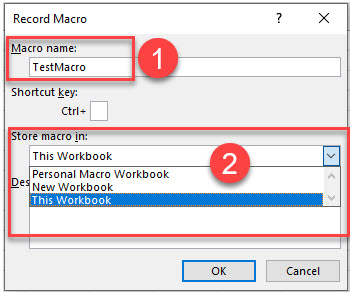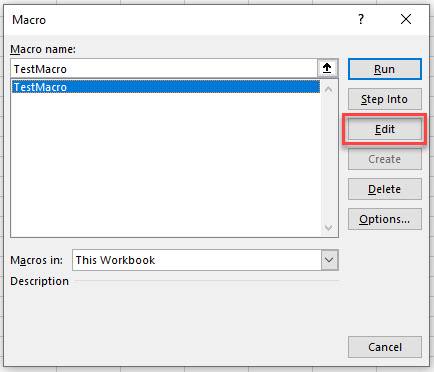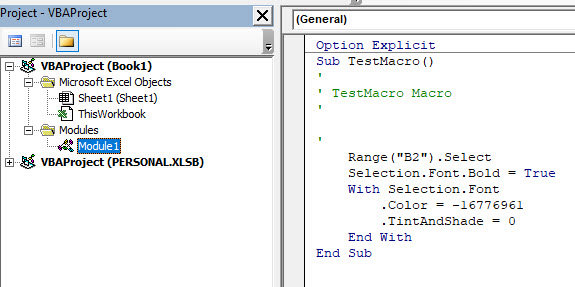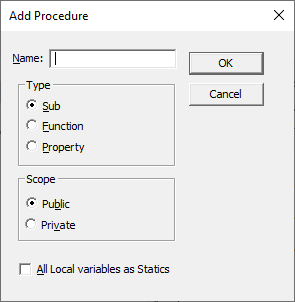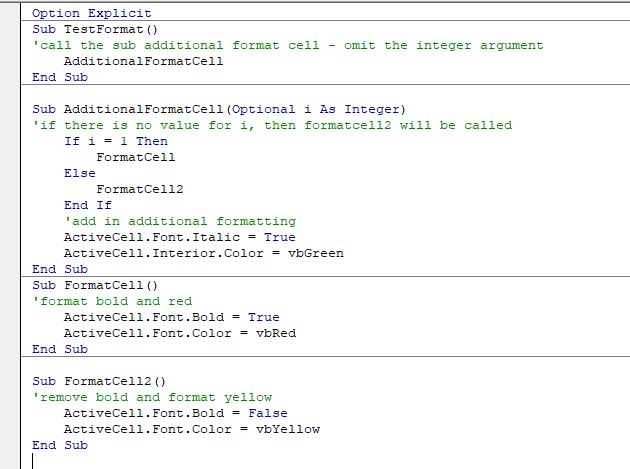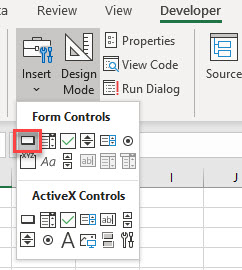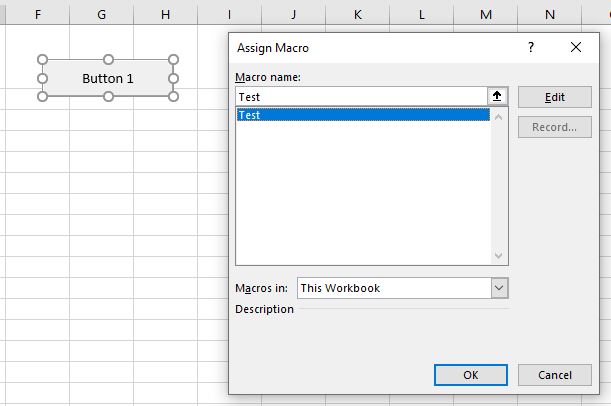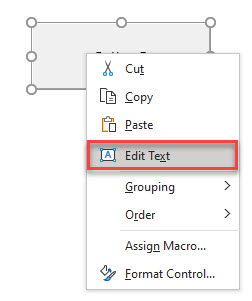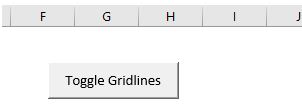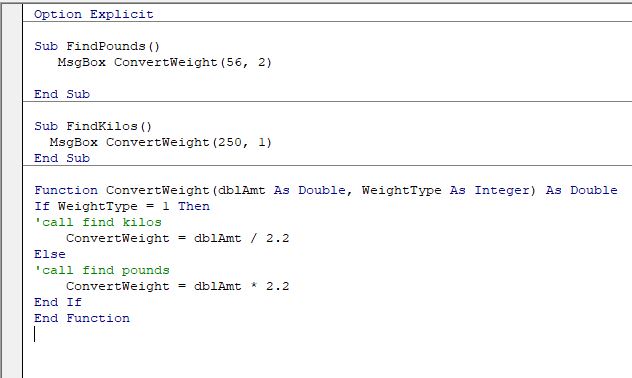
And there are good reasons for this:
If you want to become a powerful macro and VBA user, you must understand the concept of procedures, the different types of procedures and how to work with them. In fact, procedures are so important that I’ve included them among the 16 essential terms you need to know in order to learn VBA programming.
However, the post I reference above only provides an introduction to the topic of procedures. Today I’m digging much deeper and explaining, in a lot more detail, one of the most common types of procedures: VBA Sub procedures. More particularly, in today’s VBA tutorial I cover the following topics:
Let’s start with the most basic topic:
What Is A Procedure: VBA Sub Procedures And Function Procedures
When you’re using Excel’s Visual Basic Editor, a procedure is the block of statements that is enclosed by a particular declaration statement and End declaration. The main purpose of a procedure is to carry out a particular task or action.
VBA instructions are generally within a procedure. Therefore, if you want to master Visual Basic for Applications and macros, you should get familiar with this topic.
The 2 most common types of procedures in Visual Basic for Applications are Sub procedures and Function procedures. In this VBA tutorial, I focus on VBA Sub procedures. I cover Function procedures in this separate Excel tutorial.
The main difference between VBA Sub procedures and Function procedures is the following:
- VBA Sub procedures perform an action with Excel.
In other words, when you execute a VBA Sub procedure, Excel does something. What happens in Excel depends on what the particular VBA code says.
- Function procedures carry out calculations and return a value. As explained by John Walkenbach in Excel VBA Programming for Dummies, this value can be either a single value or an array.
If you’ve worked with regular Excel functions and formulas, you already have a good basis to understand how Function procedures work. Function procedures work similarly to regular Excel functions; they carry out certain calculations behind the scenes before returning a value.
According to Walkenbach, one of the foremost Excel authorities:
Most of the macros you write in VBA are Sub procedures.
Additionally, if you use the macro recorder to create a macro, Excel always creates a VBA Sub procedure.
The above comments make it quite clear that you’ll be working quite a bit with VBA Sub procedures. Therefore, let’s start taking a more detailed look at them…
How Does A VBA Sub Procedure Look Like
The image below shows how a basic VBA Sub procedure looks like in the Visual Basic Editor. Notice how, this VBA Sub procedure:
- Begins with the declaration statement “Sub”.
- Has an End declaration statement.
- Has a block of statements that is enclosed by the declaration and End declaration statements.
The purpose of this particular VBA Sub procedure, named “Delete_Blank_Rows_3”, is to delete rows when some of the cells in those rows are blank.
Before we continue, let’s take a look at the first statement of this VBA Sub procedure. There are 3 items:
- The Sub keyword which you already know is used to declare the beginning of the VBA Sub procedure.
- The name of the VBA Sub procedure.
VBA Sub procedure names must follow certain rules, which I explain in the following section.
- Parentheses.
If you’re creating a particular VBA Sub procedure that uses arguments from other procedures, you should list them here. The arguments must be separated by a comma (,).
You can have a VBA Sub procedure without arguments (they’re optional). However, the parentheses themselves aren’t. If the relevant procedure uses no arguments, such as the example above, you must have the set of empty parentheses.
I’ve described 4 elements that are required in any VBA Sub procedure:
- Sub statement.
- Name.
- Parentheses.
- End Sub keyword.
Additionally, I’ve also described 2 elements that are optional:
- The list of arguments that may go within the parentheses.
- The valid VBA instructions that are enclosed by the declaration and End declaration statements.
However, there 3 other main optional items of a VBA Sub procedure. I introduce them below…
But first, let’s take a look at how a procedure with all the most important elements (both optional and required) is structured, as explained in Excel 2013 Power Programming with VBA:
[Private/Public] [Static] Sub name ([Argument list])
[Instructions]
[Exit Sub]
[Instructions]
End Sub
You can learn more about the different parts of the Sub statement (including some that I don’t describe above) at the Microsoft Dev Center.
Now, let’s take a look at the optional elements within the above structure. You can identify these elements because I’ve written them within square brackets ([ ]).
Element #1: [Private/Public].
Private and Public are known as access modifiers.
If you type “Private” at the beginning of a VBA Sub procedure, the only procedures that are able to access it are those stored in the same VBA module.
If, on the other hand, you use “Public”, the VBA Sub procedure has no access restrictions. Despite this, if the procedure is located in a module that uses the Option Private Statement, the VBA Sub procedure can’t be referenced outside the relevant project.
I explain the topic of procedure scope below.
Element #2: [Static].
If you type “Static” before indicating the beginning of the VBA Sub procedure, the variables of the relevant procedure are preserved when the module ends.
Element #3: [Exit Sub].
An Exit Sub statement is used to immediately exit the VBA Sub procedure in which the statement is included.
How To Name A VBA Sub Procedure
Procedures must always be named. The main rules that you must follow when naming a VBA Sub procedure are the following:
- The first character must be a letter.
- Despite the above, the other characters can be letters, numbers or certain (but not any) punctuation characters.
For example, the following characters can’t be used: #, $, %, &, @, ^, * and !.
- Periods (.) and spaces ( ) are not allowed.
- There is no distinction between upper and lowercase letters. In other words “A” is the same as “a”.
- The maximum number of characters a name can have is 255.
In Excel VBA Programming for Dummies and Excel 2013 Power Programming with VBA, Excel authority John Walkenbach suggests that your VBA Sub procedure names:
- Describe the purpose of the VBA Sub procedure or what the procedure does.
- Are not meaningless.
- Usually, combine a verb and a noun.
Walkenbach goes on to explain how certain practitioners name the VBA Sub procedures using sentences that provide a complete description. In his opinion, this method has one main advantage and one main disadvantage:
- On the one hand, using sentences to name VBA Sub procedures pretty much guarantees that the names are descriptive and unambiguous.
- On the other, typing a full sentence requires more time. This may slow you down a little bit while working.
In my opinion, as long as the VBA Sub procedure names you use are descriptive, meaningful and unambiguous, you should be fine. This is an aspect where you can and should choose a style that you find comfortable and appropriate to achieve your own goals and purposes.
How To Determine The Scope Of A VBA Sub Procedure
The word scope refers to how a VBA Sub procedure may be called.
When creating a VBA Sub procedure you have the option of determining which other procedures are able to call it. This is done through the use of the Public or Private keywords that I introduce above and which are one of the optional elements of VBA Sub procedures. However, let’s take a deeper look at what is the meaning of public or private procedures, and how can you determine whether a particular VBA Sub procedure is public or private.
Public VBA Sub Procedures
VBA Sub procedures are, by default, public. When a particular procedure is public, there are generally no access restrictions.
Since the default is that procedures are public, you actually don’t need to use the Public keyword. For example, the following VBA Sub procedure, Delete_Blank_Rows_3, is public. Note that there is no Public keyword.
However, in order to make your VBA code clearer, you may want to include the Public keyword in your VBA Sub procedures. This practice is relatively common among programmers. The following screenshot shows how the VBA code of the Delete_Blank_Rows_3 macro looks like with this keyword included.
In both of the above cases, the VBA Sub procedures are public. In other words, both are essentially the same.
Private VBA Sub Procedures
As explained by Microsoft, when you use the Private keyword, the relevant element can only be accessed from within the context in which it was declared. In the case of private VBA Sub procedures, this means that they can only be accessed or called by those procedures that are stored in the same VBA module. Any procedures within any other module are not able to call it, even if those other modules are in the same Excel workbook.
For example, continuing with the Delete_Blank_Rows_3 macro, the following screenshot shows the relevant VBA code to make the VBA Sub procedure private:
How To Make All VBA Sub Procedures In a Module Private To A VBA Project
In addition to the public and private scopes that I’ve explained above, you can make all the VBA Sub procedures within a particular module accessible only from the VBA project that contains them (but not from other VBA projects) by using a single statement: the Option Private Statement.
The syntax of the Option Private Statement is: “Option Private Module”. If you decide to use it, the statement must go before the first Sub statement of the module.
For example, the following screenshot shows how the VBA code of a module with 3 macros that delete blank rows based on whether a row has empty cells. The last of these VBA Sub procedures is the Delete_Blank_Rows_3 macro that I’ve used as an example in other parts of this VBA tutorial, and doesn’t appear fully.
All of the 3 VBA Sub procedures contained in the module above can only be referenced and accessed from the VBA project that contains them.
When To Make VBA Sub Procedures Private: An Example
One way of executing a VBA Sub procedure is by having another procedure call it. You’re quite likely to use this method of running procedures in the future. In fact, in some cases, you may have certain procedures that aren’t stand-alone and are designed to be called by another Sub procedure.
If you have such procedures within a particular Excel workbook, it is advisable to make them private. If you do this, these private VBA Sub procedures aren’t listed in the Macro dialog which is one of the most common methods to execute a Sub procedure.
Don’t worry if you don’t fully understand how this works yet. I explain how to execute VBA Sub procedures both by calling them from other procedures or by using the Macro dialog below.
How To Execute / Run / Call a VBA Sub Procedure
While working with macros, you may use the terms execute, run or call when referring to the action of executing a VBA Sub procedure. As explained by John Walkenbach in Excel VBA Programming for Dummies, they mean the same thing and “you can use whatever terminology you like”.
You can execute, run or call a VBA Sub procedure in a variety of ways. In this section, I illustrate 9 of the ways in which you can execute a Sub procedure. There is an additional (tenth) option that I don’t explain in this VBA tutorial: executing a macro from a customized context menu. The reason for this is that context menu customization is a different topic that I may cover in a separate guide. If you want to receive emails whenever I publish new posts in Power Spreadsheets, please enter your email below.
The VBA Sub procedure that I use as an illustration is the Delete_Blank_Rows_3 macro that I show you above.
This Excel VBA Sub Procedures Tutorial is accompanied by Excel workbooks containing the data and macros I use throughout this Tutorial (including Delete_Blank_Rows_3). You can get immediate free access to these example workbooks by subscribing to the Power Spreadsheets Newsletter.
Option #1: How To Execute A VBA Sub Procedure Directly From The Visual Basic Editor
According to Walkenbach, this method is the fastest way to execute a VBA Sub procedure. In this case, you’re basically running the procedure directly from the module within the Visual Basic Editor.
Despite the above, I believe you’ll probably not use this method too often. In practice, you’ll usually want to execute VBA Sub procedures while you’re in Excel, not in the VBE. Some of the other options that I describe below allow you to do this.
This particular method only works when the particular VBA Sub procedure that you want to run doesn’t rely on arguments that come from another procedure. The reason for this is that this option doesn’t allow you to pass the arguments from the other procedures to the VBA Sub procedure you’re calling.
If you want to run a VBA Sub procedure that contains arguments, John Walkenbach explains that you can only do it by calling it from another procedure. That procedure from which you make the calling needs to supply the arguments that are required by the Sub procedure you want to execute.
In any case, if you choose to use this first method, you can call a VBA Sub procedure in 3 easy steps:
Step #1: Open The Visual Basic Editor.
You can open the VBE with the keyboard shortcut “Alt + F11”. Alternatively, click on the Visual Basic icon in the Developer tab of the Ribbon.
Step #2: Open The VBA Module That Contains The VBA Sub Procedure You Want To Execute.
You want the Visual Basic Editor to show you the VBA code of the Sub procedure that you want to call.
You can do this in several ways, which I explain in The Beginner’s Guide to Excel’s Visual Basic Editor. One of the methods you can use is to double-click on the relevant VBA module.
For example, if the VBA Sub procedure is within Module1, simply double-click on “Module1” in the Project Explorer of the VBE.
As a result of the above, the Visual Basic Editor displays the relevant code in the Programming Window and places the cursor there:
Step #3: Run The VBA Sub Procedure.
You can call a VBA Sub Procedure directly from the relevant module in the Visual Basic Editor using any of the following methods:
- Click on “Run Sub/UserForm” in the Run menu.
- Use the keyboard shortcut “F5”.
Option #2: How To Execute A VBA Sub Procedure Using The Macro Dialog
This method only works if the VBA Sub procedure you want to call doesn’t contain arguments. The reason for this is the same that I explained previously: You can’t specify those arguments.
Regardless of the above, this option is one of the most commonly used methods to execute VBA Sub procedures. When using it, you can run a VBA Sub procedure in 2 simple steps. Let’s take a look at them.
Step #1: Open the Macro dialog.
You can ask Excel to open the Macro dialog box in either of the following ways:
- Use the “Alt + F8” keyboard shortcut.
- Click on “Macros” in the Developer tab of the Ribbon.
Excel displays the Macro dialog, which looks roughly as follows:
Step #2: Select The Macro You Want To Execute And Execute It.
You’ve probably notice in the screenshot above that there is only 1 macro in all open Excel workbooks (Delete_Blank_Rows_3). Therefore, this is the only macro listed and, obviously, is the macro that we’ll be executing.
You already know that this method for running macros doesn’t allow you to call VBA Sub procedures that use arguments. Therefore, any such Sub procedure wouldn’t even appear in the Macro dialog.
Additionally, the Macro dialog only shows public procedures. However, you can still execute private VBA Sub procedures from the Macro dialog. To do this, type the name of the relevant private Sub procedure in the Macro name field that appears in the image below.
Similarly, the Macro dialog doesn’t show VBA Sub procedures that are contained in Add-Ins. In that case, you can also execute the procedure by typing the name of the relevant macro in the Macro name field.
In any case, the rules to select and execute a macro are the same regardless of whether you have only 1 or several macros in the open Excel workbooks. You can do the selection and execution in either of the following ways:
- Double-click on the macro you want to execute. For example, in the image below you’d double-click on the macro Delete_Blank_Rows_3.
- Click on the macro you want to execute to select it, and click on the Run button.
Option #3: How To Execute A VBA Sub Procedure Using A Keyboard Shortcut
You can execute VBA Sub procedures by using keyboard shortcuts. To run a macro using this method, simply press the relevant key combination.
This option doesn’t work for macros that use arguments. I explain the reasons for this above.
However, you may be wondering:
How does one assign a keyboard shortcut to a macro?
There are 2 main ways of assigning a keyboard shortcut to a macro.
The first method to assign a keyboard shortcut to a macro works only if you’re using the macro recorder. If this is the case, during the recording process (which I explain in detail in an Excel macro tutorial for beginners), you’ll encounter the Record Macro dialog. This dialog allows you to determine whether the macro you’ll be recording can be called by a keyboard shortcut and which keys compose that shortcut.
The second method of assigning a keyboard shortcut to a macro is perhaps more interesting. This method allows you to assign or edit the keyboard shortcut of any macro in the following 3 quick steps.
Step #1: Open The Macro Dialog.
You can access the Macro dialog by using the “Alt + F8” keyboard shortcut or going to the Developer tab and clicking on “Macros”.
Step #2: Select The Macro You Want To Assign A Keyboard Shortcut To.
On the Macro dialog, simply select the VBA Sub procedure you want to assign a macro to and click on “Options…” on the lower right side of the dialog box. For example, in the screenshot below I’ve selected the macro Delete_Blank_Rows_3.
Step #3: Assign A Keyboard Shortcut.
When Excel displays the Macro Options dialog, assign the keyboard shortcut and click on the OK button at the bottom of the dialog box.
Keyboard shortcuts are of the form “Ctrl + Letter” or “Ctrl + Shift + Letter”.
When selecting a keyboard shortcut, be mindful about what is the combination you’re assigning to the VBA Sub procedure. The reason for this is that assigned macro keyboard shortcuts override built-in shortcuts. Therefore, if you choose a shortcut that is the same as a built-in one, you’ll be disabling the latter.
For example, “Ctrl + B” is the default built-in keyboard shortcut for bold. If you were to assign the same shortcut to a macro, you’ll not be able to use the shortcut in order to make text bold.
Using keyboard shortcuts of the form “Ctrl + Shift + Letter” reduces the risk of overriding pre-existing keyboard shortcuts. In any case, remember to be careful about what is the exact combination that you assign.
Option #4: How To Execute A VBA Sub Procedure Using A Button Or Other Object
The idea behind this method is that you can assign or attach a macro to certain “objects”. I put quotations around the word objects because, in this particular case, I’m not referring to any type of object but to certain types of objects that Excel allows you to put in a worksheet. In Excel 2013 Power Programming with VBA, John Walkenbach classifies these objects into 3 classes:
- ActiveX controls.
- Form controls.
- Inserted objects, such as shapes, text boxes, clip art, SmartArt, WordArt, charts and pictures.
In this guide I explain how you can attach a macro to a button from the Form controls or to other inserted objects.
How To Assign A Macro To A Form Control Button
Let’s look at how you can attach a macro to a Form control button in just 4 steps.
Step #1: Insert A Button.
Go to the Developer tab in the Ribbon. Click on “Insert” and choose the Button Form Control. The following screenshot shows you the location of all of these:
Step #2: Create The Button.
Once you’ve clicked on the Button Form Control, you can actually create the button in the Excel worksheet by simply clicking on section of the worksheet where you want the top left corner of the button to appear.
For example, if I want the button to appear in cell B5, I click on the top left corner of that cell.
Step #3: Assign A Macro To The Button.
Once you’ve clicked on the location where you want the button to appear, Excel displays the Assign Macro dialog.
Excel suggests a macro that is based on the button’s name. In the case below, this is “Button1_Click”.
In many cases, this suggestion isn’t going to match what you want. Therefore, select the macro that you actually want to assign to the button and click on the OK button at the bottom right corner of the Assign Macro dialog.
In the example we’ve been working with, the macro to be assigned to the button is Delete_Blank_Rows_3.
Step #4: Edit Button (Optional).
Once you’ve completed the 3 steps described above, Excel shows the button that you’ve created. Now you can execute the relevant VBA Sub procedure by simply clicking on the button.
After the button has been created, you can edit it in a few ways. The following are 4 of the main things you can change:
- Size: The button created by Excel has the default size. You can change this size by dragging any of the handles with your mouse.
For example, if I want to increase the size of the button so that it covers 4 cells (B5, B6, C5 and C6), I drag the bottom right handle as required.
If the handles are not visible, you can make Excel show them by right-clicking on the button or pressing the left mouse button at the same time as the Ctrl key.
- Location: You can modify the location of the button by dragging it with your mouse.
You can only drag the button with the left button of your mouse if the handles (as shown above) are visible. Therefore, if they’re not, right-click on the button or press the left mouse button at the same time of the the Ctrl key before attempting to drag it somewhere else.
Alternatively, you can simply drag the button using the right mouse button. For example, if you want to move the button a couple of cells down, so that it covers cells B8, B9, C8 and C9, drag the button with the right mouse until the desired point. As you drag, Excel shows a shadow in the new location, but the button continues in the original spot.
Once you let go off the right mouse button, Excel displays a contextual menu. Click on “Move Here” to move the button.
- Text: To edit the text of the button, right click on the button. Excel displays a contextual menu, where you can choose “Edit Text”.
Excel places the cursor inside the button so you can modify the text as you desire. Once you’re done, click outside the button to confirm the change.
In the case used as an example throughout this VBA tutorial, a more appropriate button label is Delete Blank Rows. Once the process is completed, the button looks as follows: - Assigned macro: If necessary, you can change the VBA Sub procedure that has been assigned to any button by right-clicking on it and selecting “Assign Macro…”.
In that case, Excel takes you back to the Assign Macro dialog, which allows you to select which particular VBA Sub procedure is assigned to the button. You’re already familiar with this dialog box, which I explain above.
In addition to the above, you can edit several other aspects of the button by right-clicking on it and selecting “Format Control…”.
Excel displays the Format Control dialog. By using this dialog you can determine several settings of the macro button.
Some of the main settings you can modify from the Format Control dialog are the following:
- Font, including typeface, style, size, underline, color and effects.
- Text alignment and orientation.
- Internal margins.
- Size.
- Whether the button moves and/or sizes with cells.
How To Assign A Macro To Another Object
In addition to the ability to assign macros to Form Control buttons, Excel allows you to assign a macro to other objects. As I explain above, these objects include shapes, text boxes, clip art, SmartArt, WordArt, charts or pictures.
Attaching a VBA Sub procedure to these objects is very easy. Let’s see how to do it in the case of a WordArt object which says “Delete Blank Rows”.
Step #1: Open The Assign Macro Dialog.
To open the Assign Macro dialog, right-click on the object and select “Assign Macro…”
Step #2: Select Macro To Assign.
Once you’ve completed the first step above, Excel displays the Assign Macro dialog. You’re already familiar with this dialog box.
To complete the process of assigning a VBA Sub procedure to the object, simply select the macro you want to assign and click the OK button on the bottom right corner of the dialog box. In the example used throughout this VBA tutorial, the macro to be assigned is Delete_Blank_Rows_3.
Once you’ve completed the 2 steps above, you can execute the VBA Sub procedure by simply clicking on the relevant object.
Option #5: How To Execute A VBA Sub Procedure From Another Procedure
In Excel 2013 Power Programming with VBA, John Walkenbach explains that executing a VBA Sub procedure from another procedure is fairly common. The term used to refer to this way of running a procedure is procedure call and the code that is invoking the procedure is known as the calling code.
As explained by Microsoft, the calling code specifies the relevant Sub procedure and transfers control to it. Once the called procedure has ran, control returns to the calling code.
According to Walkenbach, there are several reasons why calling other procedures is advisable, including the following:
- As explained by Microsoft, this makes VBA code simpler, smaller and clearer. As a consequence, it is easier to understand, debug, maintain or modify.
More generally, maintaining several separate and small VBA Sub procedures is a good practice. Even though you can create very long procedures, I suggest you avoid this. Instead, when working with Visual Basic for Applications, follow Walkenbach’s suggestion of (i) creating several small procedures, and then (ii) create a main procedure that calls the other small procedures.
The following diagram shows how a possible structure of several VBA Sub procedures calling each other can work. The main procedure appears on the left side. This main procedure then calls each of the smaller VBA Sub procedures, all of which appear on the right side.
- It helps you avoid repetition and redundancies.
There are cases where you’ll need to create a macro that carries out the same action in several different places. You can either create a VBA Sub procedure that is called in all those places, or enter the full piece of VBA code each and every time. As you can imagine, having a VBA Sub procedure that is executed in those different places is a more appropriate option.
- If you have certain VBA Sub procedures that you use frequently, you can store them in a frequently-used module which can be easily imported into all your VBA projects. Once the module is imported, you can easily call those macros whenever you need them.
The alternative is to always be copying and pasting VBA code into your new VBA procedures. You’ll probably agree that the first option (importing a module with frequently-used VBA Sub procedures) is easier and faster to implement on your day-to-day work.
There are 3 methods you can use to call a VBA Sub procedure from another procedure. Let’s take a look at each of them.
Method #1: Use VBA Sub Procedure’s Name
Under this method, you enter the following 2 things in the VBA code of the calling Sub procedure:
- #1: The name of the procedure that is being called.
- #2: The arguments of the procedure that is being called. The arguments are separated by commas.
In other words, the syntax you must apply when using this method is simply “Procedure_Name Arguments”.
As a very simple example, let’s assume that you create a VBA Sub procedure that only calls the Delete_Blank_Rows_3 macro.
This new macro doesn’t make much sense, because you may as well simply execute the Delete_Blank_Rows_3 macro directly. However, since the structure is extremely simple, I’ll use it as an example so you can clearly see how this method works.
The new VBA Sub procedure is called “Calling_Delete_Blank_Rows”. The macro contains just 3 statements:
Sub Calling_Delete_Blank_Rows()
Delete_Blank_Rows_3
End Sub
The following screenshot shows the whole VBA code (including comments) as it appears in the Visual Basic Editor:
You can, obviously, add statements to the VBA Sub procedure used as an example in order to make it more realistic and useful.
Method #2: Use Call Statement
To apply this method you must proceed, to a certain extent, similarly as with method #1 above. In this particular case, you also enter the name and arguments of the procedure that is being called within the VBA code of the calling Sub procedure.
There are, as explained by Microsoft, 2 main differences between methods #1 and #2:
- In method #2, you use the Call statement. This keyword goes before the name of the procedure you’re calling.
- In method #2, the arguments of the VBA Sub procedure being called are enclosed in parentheses.
In other words, when using method #2, the syntax you must apply is “Call Procedure_Name (Arguments)”.
Let’s see how this looks in practice. Again, we’ll be creating a very simple VBA Sub procedure whose sole purpose if to call the Delete_Blank_Rows_3 macro. The VBA code behind this new macro, called “Delete_Blank_Rows_2”, is as follows:
Sub Calling_Delete_Blank_Rows_2()
Call Delete_Blank_Rows_3
End Sub
Within the Visual Basic Editor environment, this VBA Sub procedure looks as follows:
The question you may have is, if I can use method #1 which doesn’t require the use of any keyword to call another VBA Sub procedure, why would I use method #2 which requires the use of the Call keyword?
The main reason for using this method #2 is simple: clarity. In the words of John Walkenbach:
Even though it’s optional, some programmers always use the Call keyword just to make it perfectly clear that another procedure is being called.
Despite the above, Microsoft states that the use of the Call keyword is generally not recommended. According to the information available at the Microsoft Dev Center, the Call statement is usually used when the VBA Sub procedure you’re calling doesn’t begin with an identifier.
Method #3: Use The Application.Run Method
You can use the Application.Run method to run a VBA Sub procedure.
As explained in Excel 2013 Power Programming with VBA, this particular method is useful if you want to call a VBA Sub procedure whose name is assigned to a variable. Using the Application.Run method is the only way of running a procedure like that. The reason for this is that, when you use the Application.Run method, you’re taking the variable and passing it as an argument to the Run method.
You can see an example of this method being applied in the above-cited Excel 2013 Power Programming with VBA.
How To Call A VBA Sub Procedure From A Different Module
When you call a VBA Sub procedure from another procedure, the process followed to search for the relevant Sub procedure is as follows:
- First, the search is carried in the same module.
- If the desired VBA Sub procedure is not found in the same module, search among the accessible procedures in the other modules within the same Excel workbook takes place.
A logical consequence of the above is that, in order for a procedure to be able to call a private procedure, both procedures must be in the same module.
There may be cases where you have procedures that have the same name but are in different modules (they can’t be in the same module). If you try to call one of these VBA Sub procedures by simply stating its name, an error message (Ambiguous name detected) is displayed.
However, this doesn’t mean that you can’t ask Excel to execute the procedure that you want. More precisely:
If you want to call the VBA Sub procedure that is located in a different module, you need to clarify this by:
- Stating the name of the relevant module before the name of the procedure.
- Using a dot (.) to separate the name of the module and the name of the procedure.
The precise syntax you must use in these cases is “Module_Name.Procedure_Name”.
Now you know how to handle the cases where you need to call a VBA Sub procedure that is in a different module. However, there are times where you may want to run procedures that are not only in a different module but in an altogether different Excel workbook. Therefore, let’s take a look at…
How To Call A VBA Sub Procedure From A Different Excel Workbook
In Excel 2013 Power Programming with VBA, John Walkenbach explains that there are 2 main methods to execute a VBA Sub procedure that is stored in a different Excel workbook:
- Establish a reference to the other workbook.
- Use the Run method and specify the name of the workbook explicitly.
Let’s take a look at how you can use either of these methods:
Method #1: Establish A Reference To Another Excel Workbook.
You can establish a reference to an Excel workbook in the following 2 simple steps:
Step #1: Open The References Dialog.
Inside the Visual Basic Editor, go to the Tools menu and select “References…”.
Step #2: Select The Excel Workbook To Add As Reference.
Once you’ve completed step #1 above, Excel displays the References dialog.
This dialog box lists all the possible references you can use and establish. All the Excel workbooks that are currently open are listed there. Notice, for example, all the Excel workbooks that appear in the screenshot below.
In this particular case, Excel workbooks are not listed using their regular file name. Instead, they appear under their VBE project names. Since “VBAProject” is the default name for every project, the situation below (where “VBAProject” appears several times) isn’t uncommon.
In order to help you identify which particular VBA project you want to add as reference, you can use the location data that appears at the bottom of the dialog box. Alternatively, you can go back to the Visual Basic Editor and change the relevant project’s name.
In order to add an Excel workbook that is currently open as reference, double-click on it or select it (by checking the box to its left) and click the OK button.
Even though the References dialog only lists Excel workbooks that are currently open, you can also create references to workbooks that aren’t currently open. To do this, you need to first click on the Browse button on the right side of the References dialog.
The Add Reference dialog is displayed. This dialog looks pretty much like any other browsing dialog box you’ve used before. Use the Add Reference dialog to browse to the folder where the relevant Excel workbook is saved, select the workbook and click on “Open”.
In the example below, I’m adding one of the sample Excel workbooks for this post.
Once you’ve completed the step above, the relevant Excel workbook is added to the bottom of the list of Available References in the References dialog. You can then select it and click the OK button to add it as a reference.
Done! Once you’ve carried out the 2 steps above, the new references that you’ve added are listed in the Project Window of the Visual Basic Editor under the References node.
You can now start calling procedures that are in the reference Excel workbook as if they were in the same workbook of the VBA Sub procedure that is calling them. You can do this, for example, by using the Sub Procedure’s name or the Call keyword.
In Excel 2013 Power Programming with VBA, John Walkenbach suggests that, in order to clearly identify a procedure that is within a different Excel workbook, you use the following syntax:
Project_Name.Module_Name.Procedure_Name
In other words, he suggests that you first specify the name of the project, followed by the name of the module and the name of the actual VBA Sub procedure.
You’ll notice that whenever you open an Excel workbook that references another workbook, the latter is opened automatically. Additionally, you won’t be able to close the referenced Excel workbook without closing the one that you originally opened. If you try to do this, Excel warns you that the workbook is currently referenced by another workbook and cannot be closed.
Method #2: Use The Application.Run Method.
You can use the Application.Run method to execute a VBA Sub procedure.
If you choose to apply this method, you don’t need to create any reference (as explained above). However, the Excel workbook that contains the VBA Sub procedure that you want to execute must be open.
You can see an example of this method being applied in the above-cited Excel 2013 Power Programming with VBA.
Option #6: How To Execute A VBA Sub Procedure Using The Ribbon
You can customize the Ribbon in order to add a new button which is assigned to a particular VBA Sub procedure. Then, you can execute the relevant macro by simply clicking on its button.
I cover the topic of Ribbon customization (with code) in this Excel tutorial. In this particular post, I show you (in a slightly simplified manner) one of the ways in which you can add a button that allows you to execute a VBA Sub procedure from the Ribbon. As with the other sections throughout this VBA tutorial, I use the Delete_Blank_Rows_3 macro as an example.
As explained by Excel experts Bill Jelen and Tracy Syrstad in Excel 2013 VBA and Macros, this method of executing a VBA Sub procedure is most appropriate for macros that are in the personal macro workbook.
The personal macro workbook is a special workbook where you can store macros that later you can apply to any Excel workbook. In other words, the macros saved in the personal macro workbook are available when you use Excel in the same computer, regardless of whether you’re working on a different Excel workbook from the one you were when you created the macro.
Let’s check out these 5 easy steps to add a new button to the Ribbon.
Step #1: Access The Excel Options Dialog.
Right-click anywhere on the Ribbon to have Excel display a context menu. On the context menu, select “Customize the Ribbon…”.
Step #2: Choose To Work With Macros.
At the top left corner of the Customize Ribbon tab in the Excel Options dialog, you’ll see the Choose commands from drop-down menu.
This drop-down menu allows you to choose from several sub-sets of commands to browse when adding commands to the Ribbon. Click on it and select “Macros”.
Once you’ve done this, Excel displays all the Macros that you can currently add to the Ribbon on the Choose commands from list. This is the list that appears just below the Choose commands from drop-down menu, as shown in the image below.
Step #3: Select The Tab And Group Of Commands To Which You Want To Add The Macro.
The Customize the Ribbon list is located on the right side of the Excel Options dialog. Here is where you find all the commands that are currently in the Ribbon. These commands are organized by tabs and groups of commands.
For example, the screenshot below shows how, within the Developer tab, there are 5 group of commands: Code, Add-Ins, Controls, XML and Modify.
In the Customize the Ribbon list is where you’ll be able to choose the location of the button that you’re about to add to the Ribbon. You can expand and contract any tab or group of commands by clicking on the “+” and “-” signs that appear on the left side of the list.
You can also add new tabs or new command groups (and rename them) using the buttons that appear below the Customize the Ribbon list.
Therefore, you can either select a pre-existing command group or create a new one for purposes of adding a macro to the Ribbon. Below I show you how you can add a new tab and group of commands to the Ribbon.
In this example, and for purposes of organization, I add a new tab just after the Developer tab by clicking on “Developer” and the New Tab button.
I rename the tab by selecting the newly added tab and clicking on the Rename button.
Excel displays the Rename dialog. I enter the new display name (Macro Collection) and click the OK button.
I repeat the process with the command group. First, I select “New Group (Custom)” and click on the Rename button.
Excel displays a slightly different Rename dialog, which provides you the opportunity to choose a symbol that represents the new group of commands. I choose an icon, enter the new display name for the command group (Delete Blank Rows) and click the OK button.
Once everything is in order, I select the group of commands to which I want to add the macro. In this example, that command group is the newly created Delete Blank Rows group.
Step #4: Add VBA Sub Procedure To The Ribbon.
To add a macro to the Ribbon, simply select the relevant item in the Choose commands from list and click the Add button that appears in the middle of the Excel Options dialog.
The following screenshot shows how this works for the Delete_Blank_Rows_3 macro:
Step #5: Finish The Process.
Click on the OK button at the lower right corner of the Excel Options dialog to finish the process.
Excel closes the Excel Options dialog and implements the changes you’ve made. Notice how, in the case of the example, Excel has added a new tab (Macro Collection), group of commands (Delete Blank Rows) and button (Delete_Blank_Rows_3) to the Ribbon.
Once you’ve completed the process described above for any VBA Sub procedure, you’ll be able to execute it by simply clicking on the relevant button in the Ribbon. This icon is enabled even if the Excel workbook that is holding the macro is closed. If this is the case, Excel opens the relevant Excel workbook that contains the macro before actually running it.
Option #7: How To Execute A VBA Sub Procedure Using The Quick Access Toolbar
The Quick Access Toolbar is the small toolbar located on the upper left corner of Excel.
Just as with the Ribbon, you can customize the Quick Access Toolbar in order to add a button that is assigned to a VBA Sub procedure. Afterwards, you can execute the macro by clicking that button.
Also, just as with the method of executing VBA Sub procedures using the Ribbon, this method is most appropriate when the macro you want to add to the Quick Access Toolbar is stored in the personal macro workbook. However, as explained in Excel 2013 VBA and Macros, if the VBA Sub procedure you want to add to the Quick Access Toolbar is stored in the Excel workbook you’re currently working on, you can indicate that Excel should only show the button when that particular workbook is open.
I’ll cover how to customize the Quick Access Toolbar more in detail in future tutorials. For the moment, let’s take a look at how you can add a macro button to the Quick Access Toolbar in 5 easy steps.
Step #1: Access The Excel Options Dialog.
You already know one of the ways you can access the options dialog. I will be covering additional methods of doing this in future Excel tutorials.
However, for this particular case, the fastest way to access the Quick Access Toolbar tab (which is the one we need) of the Excel Options dialog is the following:
Right-click on the Quick Access Toolbar and select “Customize Quick Access Toolbar…”.
Once you’ve completed this step, Excel opens the Options dialog.
Step #2: Choose For Which Excel Workbooks The Customized Quick Access Toolbar Applies.
At the top right corner of the Excel Options dialog, you can see the Customize Quick Access Toolbar drop-down menu. This is the section that allows you to determine to which workbooks does the customized Quick Access Toolbar with the macro button applies.
Click on the Customize Quick Access drop-down menu and select your preferred option.
- If you want the macro button to appear in all Excel workbooks, select “For all documents (default)”. As implied by the description, this is the default setting.
- If the macro button should only appear in a particular Excel workbook, select that particular workbook.
The screenshot below shows the rough look of the options above when the Customize Quick Access Toolbar drop-down menu is expanded. In this particular case, the only Excel workbook that is open is called “Book 1”:
For this example, I simply leave the default option. Therefore, the customization applies to all Excel workbooks.
Step #3: Choose To Work With Macros.
At the top left corner of the Quick Access Toolbar tab in the Excel Options dialog you can find the Choose commands from drop-down menu.
Click on this drop-down menu and select “Macros”.
Step #4: Add Macro To Quick Access Toolbar.
After you’ve completed step #3 above, the Excel Options dialog displays a list of macros that you can add to the Quick Access Toolbar. You can find these macros in the Choose commands from list box which appears on the left side of the Quick Access Toolbar tab of the dialog box.
Choose the macro you want to add from the Choose commands from list box and click on the Add button that appears in the middle of the Excel Options dialog. The following screenshot shows how to add the Delete_Blank_Rows_3 macro:
Step #5: Click The OK Button.
Once you’ve completed the 4 steps above, Excel adds the relevant macro button to the Quick Access Toolbar. Notice how it appears in the Customize Quick Access Toolbar list on the right side of the Excel Options dialog:
To complete the process and implement the changes, simply press the OK button on the lower right corner of the Excel Options dialog.
Once you’re back in Excel, notice how the relevant macro button has been added to the Quick Access Toolbar.
Now you can execute the relevant VBA Sub procedure by simply clicking on the button that you’ve just added to the Quick Access Toolbar.
Option #8: How To Execute A VBA Sub Procedure When A Particular Event Occurs
Excel allows you to determine that a particular VBA Sub procedure is to be executed whenever a certain event occurs. I cover this particular topic in more detail here.
In Excel 2013 Power Programming with VBA, John Walkenbach provides several examples of events, such as the following:
- Opening an Excel workbook.
- Entering data in a worksheet.
- Saving a file.
- Clicking a CommandButton ActiveX control.
The name for VBA Sub procedures that are executed when a particular event occurs is “event handler procedure”. These procedures have 2 main characteristics that distinguish them from other types of VBA Sub procedures:
- Their names have a different structures than usual. More particularly, their name syntax is “object_EventName”. In other words, these names are composed of 3 elements:
Element #1: An object.
Element #2: An underscore.
Element #3: The name of the relevant event.
- The VBA module in which they’re stored is the module for the relevant object.
Event handler procedures are different topic that requires its own VBA tutorial. If you’re interested in learning more about this topic, please refer to Chapter 17 of the above cited Excel 2013 Power Programming with VBA.
Option #9: How To Execute A VBA Sub Procedure From The Immediate Window Of The Visual Basic Editor
Executing a VBA Sub procedure from the Immediate Window of the VBE is useful, in particular, if you’re in the middle of the developing a particular procedure within the Visual Basic Editor environment.
When displayed, the Immediate Window usually appears at the bottom of the Visual Basic Editor.
You can check out my introduction to the Immediate Window by checking my post about the Visual Basic Editor. You can find this, along with all other VBA tutorials within Power Spreadsheets, in the Archives.
In order to execute a VBA Sub procedure using the Immediate Window, simply type the name of the relevant procedure in the Immediate Window and press the Enter key.
Conclusion
The concept of procedures is frequently used in the books and blogs that cover the topic of macros and Visual Basic for Applications. If you don’t understand what Excel authorities are talking about when using this term, you’ll have a very hard time learning VBA.
Perhaps most importantly, once you reach a certain expertise level with Excel you must work with VBA Sub procedures.
Therefore, if your purpose is becoming a powerful Excel user, understanding VBA Sub procedures and mastering how to work with them is not optional. However, after reading this VBA tutorial you have a good understanding of the concept itself. Additionally, you probably also have a basic understanding of how to work with Sub procedures in practice, including the following topics:
- What is the syntax you should use when creating VBA Sub procedures.
- What rules and suggestions to bear in mind when naming a VBA Sub procedure.
- What are the different scopes that a VBA Sub procedure can have, and how you can (and whether should) limit that scope.
- What are some of the most common ways to execute a VBA Sub procedure.
Books Referenced In This Excel Tutorial
- Jelen, Bill and Syrstad, Tracy (2013). Excel 2013 VBA and Macros. United States of America: Pearson Education, Inc.
- Walkenbach, John (2013). Excel VBA Programming for Dummies. Hoboken, NJ: John Wiley & Sons Inc.
- Walkenbach, John (2013). Excel 2013 Power Programming with VBA. Hoboken, NJ: John Wiley & Sons Inc.
A Powerful & Multi-purpose Templates for project management. Now seamlessly manage your projects, tasks, meetings, presentations, teams, customers, stakeholders and time. This page describes all the amazing new features and options that come with our premium templates.
Save Up to 85% LIMITED TIME OFFER

All-in-One Pack
120+ Project Management Templates
Essential Pack
50+ Project Management Templates
Excel Pack
50+ Excel PM Templates
PowerPoint Pack
50+ Excel PM Templates
MS Word Pack
25+ Word PM Templates
Ultimate Project Management Template
Ultimate Resource Management Template
Project Portfolio Management Templates
Related Posts
-
- Procedures in Excel VBA – What is a Sub Procedure?
- Calling a Sub Procedure
- Procedures and Access Levels
- Examples on Sub Procedures – With and With Out Parameters
- Example File
Page load link
Go to Top
In this Article
- What are Sub Procedures?
- Creating a Sub Procedure with the Macro Recorder
- Creating a Sub Procedure in the VBE Window
- Calling a Sub Procedure from Another Sub-Procedure
- Adding an Argument to a Sub Procedure
- Assigning a Button in Excel to a Sub Procedure
- Creating a Function to Return a Value
This tutorial will explain VBA Sub Procedures in Excel.
What are Sub Procedures?
Sub procedure are one of the major cornerstones of VBA. A Sub procedure does things. They perform actions such as formatting a table or creating a pivot table. The majority of procedures written are Sub procedures. All macros are Sub procedures. A sub procedure begins with a Sub statement and ends with an End Sub statement. The procedure name is always followed by parentheses.
Sub Gridlines ()
ActiveWindow.DisplayGridlines = False
End SubA Sub Procedure in VBA can be created by the Macro Recorder or directly in the Visual Basic Editor (VBE).
Creating a Sub Procedure with the Macro Recorder
In the Ribbon, select View > Macros > Record Macro.
OR
Developer > Visual Basic > Record Macro
Note: If you don’t see the Developer Ribbon, you’ll need to enable it. You can learn how to do that here.
1) Type in the name for your macro, and then 2) Select where to store the macro. This can be in the Personal Macro workbook, the workbook you are currently editing or a new workbook entirely.
Once you have clicked OK, you can follow the steps that you want in your macro (for example bolding a cell, changing the color of the text, etc.), and then click the stop button at the bottom of the screen to stop recording the macro.
To view your macro, in the Ribbon, select View > Macros > View Macros.
OR
Developer > Visual Basic >Macros
Click on the Macro in the Macro name list, and then click on Edit.
This will open the VBE and jump you into the VBA Code.
A VBA Project has now automatically been created for your workbook, and within this project, a module (Module 1) has also been created. The Sub Procedure (macro) is contained within this new module on the right hand side.
Creating a Sub Procedure in the VBE Window
To create a new procedure, we first need to insert a module into our VBA Project or make sure you are clicked in the module in which you wish to store the procedure. To insert a new module into your code, click on the Insert option on the menu bar, and click Module. 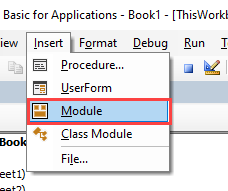
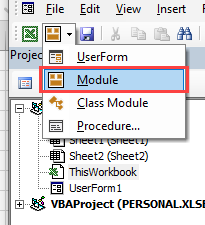
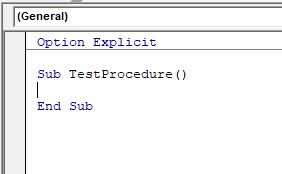
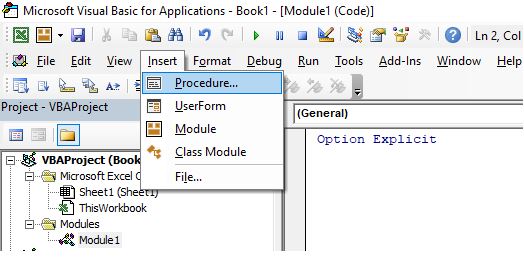
- Type the name of your new procedure in the name box – this must start with a letter of the alphabet and can contain letters and number and be a maximum of 64 characters.
- You can have a Sub procedure, a Function procedure or a Property procedure. (Properties are used in Class modules and set properties for ActiveX controls that you may have created). To create a Sub procedure, make sure that option is selected.
- You can make the scope of the procedure either Public or Private. If the procedure is public (default), then it can be used by all the modules in the project while if the procedure is private, it will only be able to be used by this module.
- You can declare local variables in this procedure as Statics (this is to do with the Scope of the variable and makes a local procedure level variable public to the entire module). We will not use this option.
When you have filled in all the relevant details, click on OK.

You then type your code between the Sub and End Sub statements.
Public Sub Test()
ActiveWindow.DisplayGridlines = Not ActiveWindow.DisplayGridlines
End SubThe code above will switch off the gridlines in the active window if they are on, but if they are off, it will switch them on!
Calling a Sub Procedure from Another Sub-Procedure
Often we write code that can then be used repetitively throughout the VBA Project. We might have a macro that format a cell for example – perhaps makes the text bold and red, and then in a different macro, we also want to format the cell, as well as do some other stuff to the cell. In the second procedure, we can CALL the first procedure, and then continue with our additional code.
Firstly, we create the first procedure:
Sub FormatCell ()
ActiveCell.Font.Bold = True
ActiveCell.Font.Color = vbRed
End SubThen, in a second procedure, we can refer to the first procedure to run that procedure as well.
Sub AdditionalFormatCell()
'call first procedure
FormatCell
'add additional formatting
ActiveCell.Font.Italic = True
ActiveCell.Interior.Color = vbGreen
End SubSo while the first procedure will make a cell bold and the text red, the second one will in addition to the first one, add italic and make the background of the cell green.
Adding an Argument to a Sub Procedure
We can further control how our code works by adding an argument or arguments to our Sub-Procedure.
Consider the following:
Our sub-procedure TestFormat, is calling the procedure AdditionalFormatCell. Although we have an argument for that procedure, we have marked it as Optional. An optional argument means that you do not have to pass the value to the procedure.
Due to the fact that we are not passing a value, the value of i will be zero – therefore the procedure FormatCell2 will be called instead of FormatCell. If we have passed a value to i – as long as that value was 1, then FormatCell would have been called instead.
Assigning a Button in Excel to a Sub Procedure
Once we have created a macro in Excel VBA, we can create a button on the worksheet to run the macro. We need the Developer tab switched on to do this.
In the Ribbon, select Developer > Insert > Form Controls > Button.
Click and drag in the worksheet to create a button. As soon as you release the mouse button, the assign macro dialog box will appear.
Select the macro you wish to assign to the button, and click OK.
Right click on the button, and select Edit Text to change the text on the button.
Click on the button to run the macro.
VBA Coding Made Easy
Stop searching for VBA code online. Learn more about AutoMacro — A VBA Code Builder that allows beginners to code procedures from scratch with minimal coding knowledge and with many time-saving features for all users!
Learn More
Creating a Function to Return a Value
A Function procedure differs from a Sub Procedure in that it will return a value. It can have multiple arguments, and the value it returns can be defined by a data type (eg: Text, Number, Date etc).
Function ConvertWeight(dblAmt As Double, WeightType As Integer) As Double
If WeightType = 1 Then
ConvertWeight = dblAmt / 2.2
Else
ConvertWeight = dblAmt * 2.2
End If
End FunctionWe can then create 2 Sub Procedures to use this function. One to convert from pounds to kilos and the other from kilos to pounds.
Excel VBA Sub Procedure
SUB in VBA is also known as a subroutine or a procedure that contains all the code. It is an inbuilt statement in VBA, and when used, it automatically gives us the statement of the end sub. The middle portion one may use for coding, the sub statement can be both public and private, and the subprocedure’s name is mandatory in VBA.
Sub means Sub Procedure in VBA. Sub Procedures are used to perform a specific set of tasks provided in the form of code. It performs only the task mentioned in the code as per the VBA language but does not return any value.
Table of contents
- Excel VBA Sub Procedure
- How to write VBA Sub Procedures?
- Example #1 – Simple Sub Procedure
- Example #2 – Simple Subroutine Task
- Types of VBA Subroutine
- Recommended Articles
- How to write VBA Sub Procedures?
You are free to use this image on your website, templates, etc, Please provide us with an attribution linkArticle Link to be Hyperlinked
For eg:
Source: VBA Sub (wallstreetmojo.com)
How to write VBA Sub Procedures?
You can download this VBA Sub Procedure Template here – VBA Sub Procedure Template
It is important to understand the structure of the sub procedure to write sub procedure codes. Below is the structure.
Sub [Name of the Procedure] (Parameters)
[What needs to be done?])
End Sub
To start the sub procedure, we need to use the word “Sub.” We need to give a name to the Sub as a procedure name. Procedure Name is nothing but our macro name. We do not usually have parameters inside the parenthesis in the VBA sub procedure.
After writing the Sub Procedure name, we need to write the tasks that we need to do. Then comes the End statement, i.e., End Sub.
Example #1 – Simple Sub Procedure
Now, take a look at the simple sub procedure writing methods.
Step 1: Start the word “Sub” in the module.
Step 2: Now name the macro name or procedure name.
Step 3: After giving the name to the sub procedure, just hit the enter key. It will automatically apply the end statement.
Now, we can see two things here, one is the start, and another is the end of the subprocedure. For better understanding, we can call it “Head” and “Tail.”
Between the head and tail of the macro, we need to write our code to perform some tasks.
Example #2 – Simple Subroutine Task
Now, we will see how to perform some simple actions here.
Assume you want to insert the value “Excel VBA” in cell A1.
Step 1: Start the sub procedure by using the above methods.
Code:
Sub Action1() End Sub
Step 2: To access cell A1 we need to use the word RANGE.
Code:
Sub Action1() Range( End Sub
Step 3: It asks what cell1 you want to refer to is? In this case, it is an A1 cell.
Code:
Sub Action1() Range ("A1") End Sub
Step 4: We need to insert the value “Excel VBA,” so select the VALUE property by putting a dot after the range.
Code:
Sub Action1() Range("A1").Value End Sub
When you start typing the word VALUE, you will see many options. These options are called an IntelliSense list, which predicts based on your typing. It is like how formulas will appear in the worksheet when we start typing the formula.
Step 5: After selecting VALUE, put an equal sign and enter the value in doubles quotes as “Excel VBA.”
Code:
Sub Action1() Range("A1").Value = "Excel VBA" End Sub
So, we have completed it.
Now, we need to execute this task. To execute the task, we had a return. So, we need to run this code by pressing the RUN button in the visual basic editor window.
We can press the excel shortcut keyAn Excel shortcut is a technique of performing a manual task in a quicker way.read more by placing the cursor inside the Macro code.
As soon as you run the code, you will get the “Excel VBA” value in cell A1.
Types of VBA Subroutine
We have two more types in sub procedure: Public Sub Procedure and Private Sub Procedure.
The words “Public” and “Private” are accessibility modifiers that allow us to use them differently.
- Public Sub Procedure allows us to use the procedure in all the workbook modules.
- Private Sub Procedure allows us to use the procedure only in the current module.
For example, look at the below image of the Public Code, which is there in Module 1.
Now, in Module 2 also, we can use this sub procedure.
Action1 is the name of the sub procedure we have used in Module 1.
In Module 2, we have mentioned it as “Call Action1”. It means when you run the sub procedure, it will execute the subprocedure Action1 from Module 1.
One cannot access Private Sub Procedures from a different module. We need to access them from the same module only.
Recommended Articles
This article has been a guide to VBA Sub. Here, we learn how to invoke a sub procedure in Excel VBA and types of subroutines, along with examples and downloadable templates. Below are some useful articles related to VBA: –
- VBA StrConv
- VBA MOD
- VBA Worksheet Function
- VBA Time
- VBA Write Text File
A Sub Procedure is an action that is written in VBA code. It starts with a Sub statement and ends with an End Sub statement. It is used to manipulate the data in an Excel sheet which includes a table present in an Excel sheet or a pivot table present in the Excel sheet. The name of the procedure should be followed by parentheses. Let’s learn why to use sub procedure:
- Converts large piece of codes into small parts so that the computer ignores all kind of complexities that arises because of large codes
- In a program, we have to access the database frequently. In this case, instead of writing the code again and again we can simply create a function to access the database. Reusability of code can be done.
Naming Rules of Sub Procedure
- It can start with a letter or an underscore but it cannot start with a number or a special character.
- It cannot contain any space in the name.
- The name of the subprocedure cannot be a keyword like Private, Sub, End, etc.
Syntax
Sub name_procedure ()
End Sub
Let’s discuss different ways to create Sub Procedure:
Creating a Sub Procedure with Macro
Step 1: Select View in the Ribbon then click on Macros to select Record Macro
Step 2: Change the Macro name according to the user’s need and then select where we want to store the macro, currently, we are storing it in This Workbook.
Step 3: To view or run the macro press Alt+F8 and then click on Edit to open the VBA to write Sub Procedure.
Then VBA Window will appear with a Sub Procedure name of Test_Procedure
Creating a Sub Procedure in VBA window
Step 1: Press Alt+F11 in the main Excel window to the VBE window.
Step 2: Select Insert and then click on Procedure.
Step 3: Add Procedure dialog box will appear.
- We can set the Sub Procedure name in the Name box, here the name of the Sub Procedure is Test_Procedure.
- We have to select Sub in the Type to create a Sub Procedure.
- We can select the scope of the procedure either Public or Private. The public will allow us to use a procedure in all the modules in the workbook whereas the private will not allow using a sub-procedure of one module in another module
- If we want to make our local variables public so they will be accessible to the entire module then select the check box of All Local variables as Statics
Step 4: Click on Ok to get Sub Procedure.
Creating a Button to Run Macro
Step 1: Select the developer tab and click Insert drop-down list from the control box.
Step 2: Choose the command button from the Form Controls Box.
Step 3: Draw the command button in the excel sheet then an Assign Macro dialog box will appear where we can select the macro to assign the Button.
Step 4: Click on the Button to run the macro.
Step 5: Press “Alt+F11” to get the sub-procedure of Button1_Click().
Step 6: Subroutine will be created inside the sub-procedure. The following code will insert a value in the Range “B1”.
Types of VBA Subroutine
There are two types in Sub procedures:
- Private Sub procedure: The procedure can’t be accessed by other modules in the workbook.
- Public Sub procedure: A procedure of one module can be accessed by the procedure of another module in the workbook. In the following code, a Sub procedure Act1() is present in Module 1.
Act1() can be called by another Sub procedure Act2() which is present in Module 2.















































































